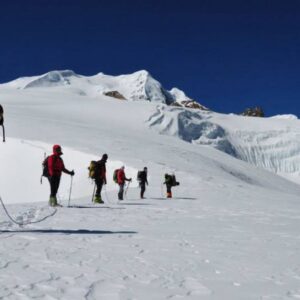
Trip Facts
-
- Duration
-
- pax
-
- Altitude
-
- Difficulty
Trip Info
Dhaulagiri (8167m.) was first climbed by the Swiss in 1960. Its name is derived from Sanskrit “dhavala means” means “White” and girl is “Mountain” The mountain was sighted by British surveyors in India in the early 1800s and was mapped by one of the secret Indian surveyors, the pundits, in 1873, but the region remained largely unknown until a Swiss aerial survey in 1949.
Overview
Dhaulagiri (8167m.) was first climbed by the Swiss in 1960. Its name is derived from Sanskrit “dhavala means” means “White” and girl is “Mountain” The mountain was sighted by British surveyors in India in the early 1800s and was mapped by one of the secret Indian surveyors, the pundits, in 1873, but the region remained largely unknown until a Swiss aerial survey in 1949.
The French Annapurna expedition in 1950 had permission to climb either Annapurna or Dhaulagiri but decided on Annapurna after a reconnaissance of Dhaulagiri . A Swiss party failed in 1953 as did an Argentine group one year later.
After four more expeditions had failed, eight members of a Swiss expedition reached the summit in 1960. The climb followed a circuitous route around the mountain from Tukuche, over Dhampus pass as French Col, to approach the summit from the North-East Col. The expedition was supplied by a Swiss Pilatus Porter aircraft, the “Yeti” which landed on the North-East Col at 5977m. Near the end of the expedition the plane crashed near Dhampus pass and the pilots, including the famous Emil Wick, walked down the mountain to Tukuche.
Tragedy struck in 1969 when an avalanche killed seven members of a US expedition on the East Dhaulagiri Glacier. The peak was climbed by the Japanese in 1970s, the Americans in 1973 and the Italians in 1976. Captain Emil Wick airdropped supplies to the US expedition from a Pilatus Porter aircrafts. Among the delicacies he dropped were two bottles of wine and a live chicken. The Sherpas would not allow the chicken to be killed on the mountain, so it became the expedition pet. It was carried, snow-blind and crippled with frostbitten feet, to Marpha, where it finally ended up in the cooking pot.
Outline Itinerary
-
Day 1
Arrival Kathmandu & transfer to hotel
-
Day 2
Preparing Expedition & Briefing
-
Day 3
Preparing Expedition & Briefing
-
Day 4
Drive by Bus to Beni & Galeshor Camp
-
Day 5
Galeshor - Tato Pani
-
Day 6
Tatopani - Ghasa
-
Day 7
Larjung - Marpha
-
Day 8
Marpha - Yak Khark
-
Day 9
Yak Khark - Dhaulagiri Base Camp
-
Day 10
Climbing Period of Dhaulagiri 8167m.
-
Day 11
Climbing Period of Dhaulagiri 8167m.
-
Day 12
Climbing Period of Dhaulagiri 8167m.
-
Day 13
Climbing Period of Dhaulagiri 8167m.
-
Day 14
Climbing Period of Dhaulagiri 8167m.
-
Day 15
Climbing Period of Dhaulagiri 8167m.
-
Day 16
Climbing Period of Dhaulagiri 8167m.
-
Day 17
Climbing Period of Dhaulagiri 8167m.
-
Day 18
Climbing Period of Dhaulagiri 8167m.
-
Day 19
Climbing Period of Dhaulagiri 8167m.
-
Day 20
Climbing Period of Dhaulagiri 8167m.
-
Day 21
Climbing Period of Dhaulagiri 8167m.
-
Day 22
Climbing Period of Dhaulagiri 8167m.
-
Day 23
Climbing Period of Dhaulagiri 8167m.
-
Day 24
Climbing Period of Dhaulagiri 8167m.
-
Day 25
Climbing Period of Dhaulagiri 8167m.
-
Day 26
Climbing Period of Dhaulagiri 8167m.
-
Day 27
Climbing Period of Dhaulagiri 8167m.
-
Day 28
Climbing Period of Dhaulagiri 8167m.
-
Day 29
Climbing Period of Dhaulagiri 8167m.
-
Day 30
Climbing Period of Dhaulagiri 8167m.
-
Day 31
Climbing Period of Dhaulagiri 8167m.
-
Day 32
Climbing Period of Dhaulagiri 8167m.
-
Day 33
Climbing Period of Dhaulagiri 8167m.
-
Day 34
Climbing Period of Dhaulagiri 8167m.
-
Day 35
Climbing Period of Dhaulagiri 8167m.
-
Day 36
Climbing Period of Dhaulagiri 8167m.
-
Day 37
Climbing Period of Dhaulagiri 8167m.
-
Day 38
Prepared for coming back
-
Day 39
Dhaulagiri Base camp - Yak Khark
-
Day 40
Yak Khark - Jomsom
-
Day 41
Jomsom - Pokhara
-
Day 42
Pokhara - Kathmandu
-
Day 43
Kathmandu
-
Day 44
Kathmandu
-
Day 45
Final Departure

